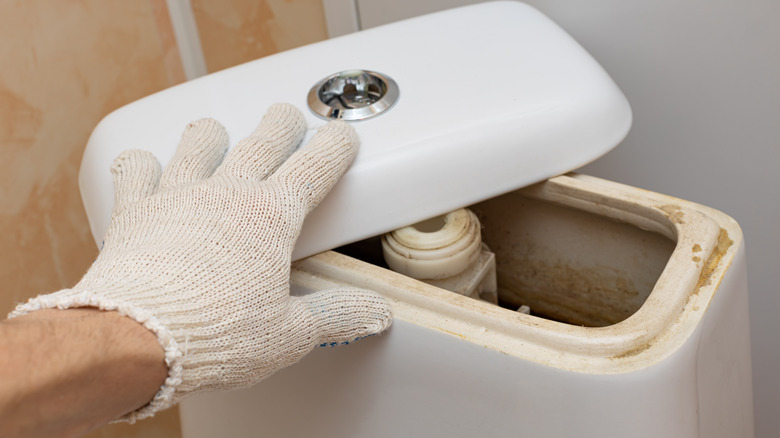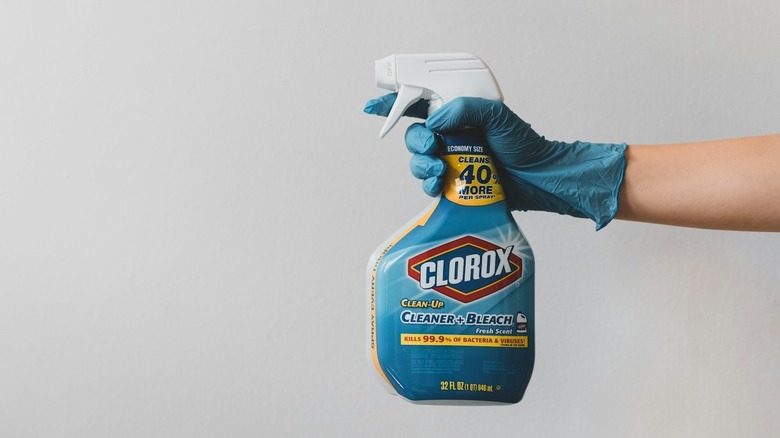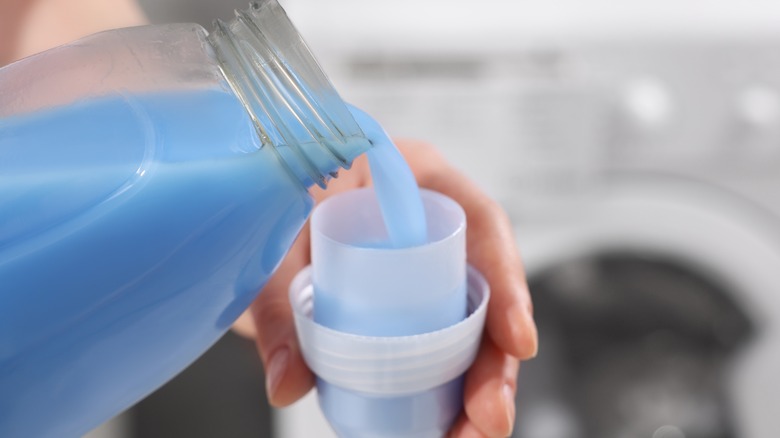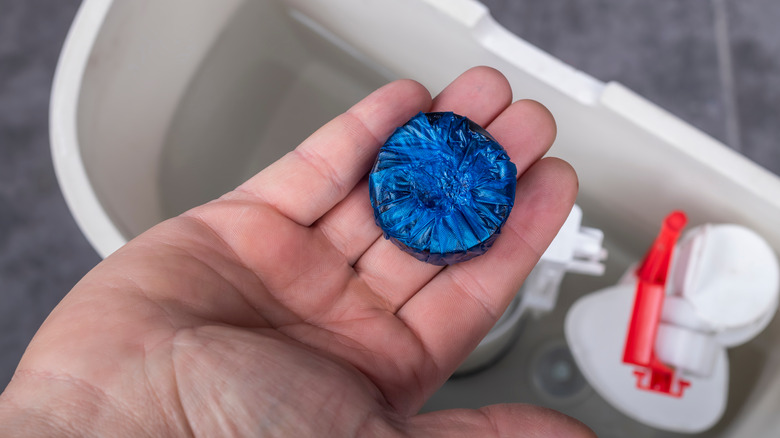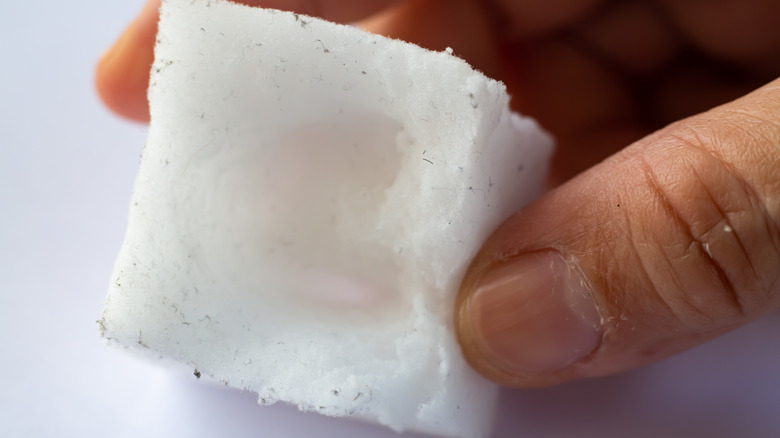Cleaning Items You Should Never Add To Your Toilet Tank
The bathroom is one of the grimiest areas in a house, so it's no surprise people scout ways to clean every inch of it. It is, after all, home to the toilet bowl, which contains an average of 3.2 million bacteria per square inch. Because of this, we look for efficient ways to clean the commode, and sometimes that extends to the toilet tank. All of it is connected, after all, cleaning the tank might have an effect on keeping the toilet bowl sparkling. But as it turns out, tinkering with the tank might cause more harm than good. Certain cleaners can wear down the rubber and plastic parts in the tank, causing damage and leaks. In addition, throwing tablets into the tank can also cause temporary clogs, which will impede flushing and mess with the water level.
Because of this, there are certain products you shouldn't add to your water tank, no matter how tempting. For example, bleach cleaners might seem like they can clean your bowl without you needing to take out a brush, but they can corrode its internal parts. You also might want to put scented fabric softener into the tank to help the commode smell nicer, but that can cause some serious damage to the plumbing. Here is a closer look into what cleaning items you should never add to your toilet tank.
Never add bleach to your tank
The toilet bowl harbors all sorts of harmful bacteria, but bleach can help neutralize them. For example, according to the Journal of Applied Microbiology, Salmonella is commonly found underneath the toilet rim, and it can stay active for up to 50 days. It can also spread throughout the room if the toilet is flushed without the lid being closed, so it's essential to routinely clean the bowl to lower its risk of spreading. However, it can also contaminate your toilet brushes, so some people choose to clean the bowl sans any tools. Instead, they put a powerful cleaner such as bleach in their toilet tank with the hopes that it will keep their toilets clean. They might also use it in an effort to clean the inside of the tank itself, which requires a bi-annual scrub. However, this can damage the internal components of the tank.
"The biggest don't when it comes to toilet tanks is bleach — do not use bleach or products containing bleach inside the tank, as it can corrode the internal parts of your toilet," Patty Stoffelen, a bath fixtures merchant for The Home Depot, shared with Martha Stewart. Your tank has a rubber gasket that connects the tank to the toilet, and bleach can eat away at it, causing future leaks. In addition to that, the overflow tube, fill valve, and float ball are all plastic, which can also be worn down by the corrosive cleaner.
Skip the Fabuloso
TikTok is filled with viral cleaning hacks, and one popular one that swept CleanTok was putting Fabuloso into the toilet tank. The hack involved cutting a slit into the cleaning product's bottle and putting it into a corner of the tank. The water then turns blue and scented, and it runs down to the bowl. This is meant not only to clean the bowl but also to scent the bathroom, killing two birds with one stone. However, much like how bleach can harm the internal workings of the commode, so can Fabuloso.
"The plastic parts on fill valves and the rubber on flappers/seals get eaten away much faster when these cleaning chemicals are added," Nicholas Hotujec, owner of Cheddar's Plumbing, told Consumer Reports. "Your toilet may be a bit cleaner, but you'll be calling a plumber to come change the guts of the toilet a lot sooner than you think." When those specific parts become degraded, the toilet can begin to leak. But that's not the only issue. Since the bottle itself takes up some space — and your tank can only hold so much volume — you will be removing some of the water that is needed to make the toilet work. "If your toilet is designed to use 1.28 gallons of water, and it's now using less than that because the bottle volume has displaced some of it, this will weaken your flushing power," Alexander Siv of Amherst Plumbing and Heating told Family Handyman.
Don't put fabric softener in your tank
Another TikTok hack that promised to make your commode smell more pleasant with every flush is putting fabric softener in your toilet tank. The idea is to pour a cup of softener into your tank, scenting the standing water. When you flush, the softener will make its way to the bowl and release its fragrance. While it will make the bathroom smell like laundry, it will also wreak havoc on the commode's plumbing. Fabric softener keeps your clothes smooth and static-free by wrapping them in a thin, waxy coating. Since the product is oil-based, pouring it down your toilet pipes is similar to pouring grease down them. As you can imagine, this can lead to major headaches later down the road.
"We've all seen the mess fabric softener can leave in a washing machine drawer. Over time it leaves a sticky film, which can coagulate and block your washing machine," Izzy Shulman, director at Plumbers4U, told Ideal Home. "If added to a toilet this means it may build-up and stick somewhere in your drainage." It can also cause major problems if you have a septic tank. It will wipe out the beneficial bacteria biome in the container that helps break down the solids in the tank, which can lead to more frequent maintenance calls.
Avoid toilet tablets
What about products specifically designed to be dropped into the toilet tank, like chlorine or bleach tablets? As it turns out, those aren't very safe either. These tablets are specifically designed to be dropped into the tank, but they don't dissolve quickly. Instead, they have a slow-release technology, which means they can take days, if not weeks, to fully break down. This is what allows the tablet to clean the bowl with every flush for several weeks. However, that also means you have chlorine- or bleach-steeped water sitting in your tank for that amount of time. This will damage the plastic or rubber mechanisms in the tank.
In addition, the tablet itself can become a hindrance. As it bobs around the tank, it can accidentally become caught in the flush valve, which will block the water from leaving the tank and into the bowl. This will make it difficult for the bowl to refill, which can make for some awkward moments or lead to expensive plumber bills. To avoid that, it's best to skip the cleaning tablets altogether.
Don't add any Magic Erasers to your tanks
Another viral TikTok cleaning hack involved dropping a Magic Eraser into your toilet tank. The idea behind this cleaning shortcut was that the Magic Eraser wasn't just a melamine sponge but a melamine sponge saturated with cleaning agents. Because of this, it would work much like a toilet tab. The cleaner would saturate the water, and the cleaning agent would flow down to the bowl each time you would flush, effectively cleaning it. However, that's not how Magic Erasers work.
There aren't any cleaners inside of them. Their cleaning power comes from the melamine foam, which is soft to the touch but gritty on a molecular level. Because of this, it acts like delicate sandpaper, gently sanding away stubborn stains or scuffs. You would have to physically scrub at a stain for it to lift. "What people might not realize is that the Magic Eraser provides a mechanical clean, meaning there is no added chemistry in the Original and Extra Durable Erasers," Morgan Brashear, the scientific communications manager at Procter & Gamble, told Apartment Therapy. "At best, the Magic Eraser might act as an additional filter in the tank of your toilet, but there aren't any cleaning chemicals inside the Eraser to be dispersed into the water as you flush." It's better to skip this hack because of that.
